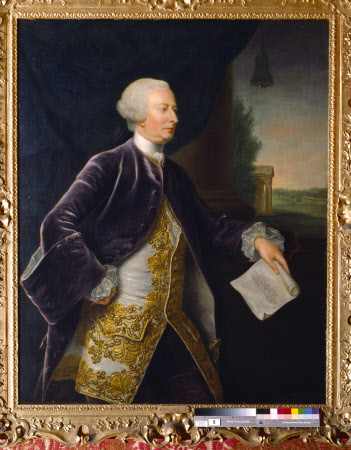John Chute (1701-1776)
Gabriel Mathias (1719 – Acton 1804)
Category
Art / Oil paintings
Date
1758 (signed and dated)
Materials
Oil on canvas
Measurements
1230 x 980 mm
Place of origin
England
Order this imageCollection
Vyne Estate, Hampshire
NT 719370
Caption
This three-quarter-length portrait, although signed and dated by Gabriel Mathias in 1758, was once attributed to the Grand Tourist artist, Pompeo Batoni. It shows John Chute, who succeeded his brother in 1754, standing in front The Vyne's famous portico. He is wearing a sumptuous mauve coat, white satin and a gold embroidered waistcoat typical of a gentleman of the period. He is holding a drawing of his own for a redesign of the house in the Gothic style which he favoured. His friend Horace Walpole, of Strawberry Hill, called him 'my oracle of taste.' It was never actually built here but realised nearby at Donnington Grove, Newbury.
Summary
Oil painting on canvas, John Chute (1701-1776) by Gabriel Mathias (1719 – Acton 1804), signed and dated: G Mathias Pinx 1758 (GM in monogram). A three-quarter-length portrait, standing to right, his right hand on his hip, his left resting on a plinth holding a drawing of The Vyne (a drawing resembling this, by Chute, is at The Vyne), redesigned as a Gothic building; he wears a mauve coat and white satin, gold embroidered waistcoat; in the background the portico of The Vyne. John was the second son of Edward Chute. He succeeded his brother Anthony to The Vyne in 1754. A friend of Horace Walpole and of Thomas Gray, he was an amateur architect with Gothic proclivities. He intended to Gothicise The Vyne, but did not carry this through and instead redesigned the Staircase in a classical style. He never married and was succeeded by a cousin through the female line, Thomas Lobb. As an architect he is best known for Donnington, the Gothic house near Newbury. Walpole described him as 'my oracle in taste'. Mathias was a pupil of Batoni and is the only British subject ever recorded as resident in the same house as the artist.
Provenance
Probably one of the "5 pieces ditto [i.e. family pieces], in gilt frames", hung with the two whole lengths in gilt rocaille frames still there, in the then Dining Room [now Library], as recorded in the 1776 inventory?; 1842 Inventory [Oak] Gallery: "A ditto [Portrait] (John Chute Esq.), in ditto [= carved & gilt frame]"; between 1842 and 1879, in the Large Drawing Room (see Martha Chute's watercolour); 1880s Notes, in the Dining Room: "John Chute (Pompeo Batoni)"; bequeathed with The Vyne, estate and contents by Sir Charles Chute, 1st Bt (1879-1956)
Credit line
The Vyne, The Chute Collection (National Trust)
Marks and inscriptions
Signed and dated 1758
Makers and roles
Gabriel Mathias (1719 – Acton 1804), artist previously catalogued as attributed to Pompeo Girolamo Batoni (Lucca 1708 – Rome 1787), artist
References
Waterhouse 1981 Ellis K. Waterhouse, The Dictionary of British 18th-century Painters in oils and crayons, Woodbridge 1981 , p.234, repd. Clark and Bowron 1985 Anthony M. Clark & Edgar Peters Bowron (ed.), Pompeo Batoni A Complete Catalogue of his Works with an Introductory Text, Oxford 1985, no. 97
